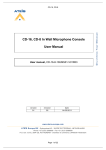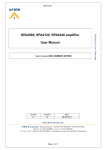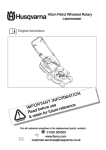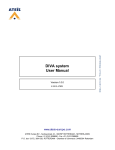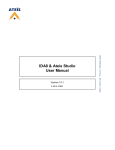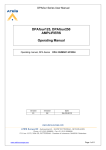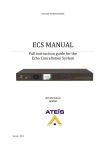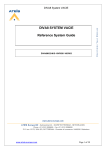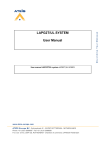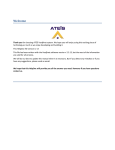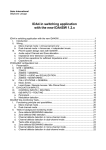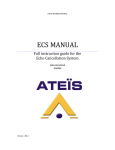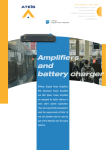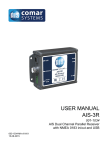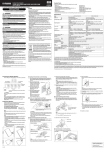Download PSSG2 – CD Touch Microphone Console User Manual
Transcript
PSSG2 – CD Touch Microphone Console User Manual PSSG2-CD-T-10UMS01-V01R01 version 01 revision 01 date 14-09-2011 www.ateis-europe.com AT EÏS Europe BV - Sydneystraat 42 - 3047BP ROTTERDAM - NETHERLANDS Phone +31 (0)10 2088690 - Fax +31 (0)10 2088699 P.O. box 12172, 3004 GD, ROTTERDAM - Chamber of commerce: 24465391 Rotterdam Page 1 of 33 DELIVERING Your MESSAGE PSSG2, CD-Touch series PSSG2, CD-Touch series 1. Table of Content 1. Table of Content ______________________________________________ 2 1. Welcome: ____________________________________________________ 4 1.1. Ateis Presentation __________________________________________________ 4 2. EC Declaration of Conformity ____________________________________ 6 3. EC Declaration of Conformity ____________________________________ 8 4. PSSG2, CD-TOUCH System Presentation _________________________ 10 5. Hardware Presentation ________________________________________ 12 6. LED Indicators _______________________________________________ 14 7. Common and Default Control Keys and indicators _________________ 14 8. Configuration ________________________________________________ 15 8.1. General options ___________________________________________________ 16 8.2. Audio Input and Output settings _____________________________________ 17 8.2.1. 8.2.2. 8.2.3. Microphone Input settings: _______________________________________________ 17 Jack Input: (Not available on CD-Touch) ____________________________________ 18 Telephone mode: (Not available on CD-Touch) ______________________________ 18 8.3. Screen calibration _________________________________________________ 19 8.4. Mechanical Buttons _______________________________________________ 20 9. Working with the VACIE System ________________________________ 22 9.1. Busy zone indication ______________________________________________ 22 9.2. Starting a microphone call __________________________________________ 22 9.3. Starting a message ________________________________________________ 23 9.4. Scrolling through pages ____________________________________________ 24 9.5. Adjusting the talking distance _______________________________________ 25 9.6. Monitoring speaker ________________________________________________ 25 10. PSSG2, CD-TOUCH connections ________________________________ 25 10.1. RS485 through CAT5 _____________________________________________ 25 10.1.1. PSSG2, CD-TOUCH on DIVA8 ___________________________________________ 26 10.1.2. PSSG2, CD-TOUCH on IDA8 ____________________________________________ 26 10.1.3. PSSG2, CD-TOUCH on IDA4 ____________________________________________ 28 10.2. Connecting an external microphone ________________________________ 29 10.3. Connecting an external headphones ________________________________ 29 10.4. Connecting a telephone handset ___________________________________ 29 11. PSSG2, CD-TOUCH troubleshooting guide ________________________ 30 11.1. PSSG2, CD-TOUCH can’t boot _____________________________________ 30 11.2. Noise in the speaker _____________________________________________ 30 11.3. PSSG2, CD-TOUCH is powered ON but no key configuration is visible____ 30 11.4. PSSG2, CD-TOUCH display is blocked ______________________________ 30 Page 2 of 33 PSSG2, CD-Touch series 11.5. state PSSG2, CD-TOUCH is connected to VACIE but there is a connection fault 30 12. Safety Declaration ____________________________________________ 31 13. International sales and service points ____________________________ 33 Page 3 of 33 PSSG2, CD-Touch series 1. Welcome: Thank you for choosing ATEÏS PSSG2. We (at ATEÏS) hope you will enjoy using this exciting piece of technology as much as we enjoy developing and building it. This Help file Manual version is: Ver: PSSG2-10UMS01-V01R01. This manual is intended to provide users the necessary understanding to safely uses PSSG2 system as well as guide users through all configuration procedures. This manual can be updated at any time without prior notice in order to keep this manual up to date. In case of errors in this manual or not clear process description, feel free to submit us mistakes, suggestions or questions by sending an email. This document intends to be a complete manual and ATEIS hopes that this Help file manual will provide you all information or answers needed. However if you have any questions, feel free to contact us. 1.1. Ateis Presentation With more than twenty years of experience, ATEÏS has quickly established itself as a leading manufacturer of Public Address, Voice Alarm systems and counter intercoms. The constant growth of market share in Europe provides confirmation of the quality of ATEÏS’s commercial and technical approach. Products: The company now offers a full range of sound equipment: microphones, preamplifiers, digital processors, digital audio matrixes, loud-speaker monitoring systems, amplifiers, etc. ATEÏS designs and manufactures leading products in the voice alarm systems market which have been certified EN60849 compliant by the TÜV. Development: Thanks to a development team that includes thirty engineers, and to constant investment, we are able to respond rapidly to the demands of our various markets with specific solutions and cutting edge technology. We have distributors in more than fifteen countries in Europe and the Middle East, with whom we have carried out major projects. In choosing ATEÏS, you are guaranteed a trustworthy partner that can be counted on for the long term. ATEÏS Field: ATEÏS's audio systems have been installed in the following markets: - Railways - Subways - Airports Page 4 of 33 PSSG2, CD-Touch series - High raise buildings - Hotels - Restaurants - Shopping malls - Theme parks - Places of worship - Stadia. - Museums. - Industrial buildings - Industrial plants - Commercial buildings Page 5 of 33 PSSG2, CD-Touch series 2. EC Declaration of Conformity Certification Body: Distributed by: Intertek commercial and electrical Intertek House, Cleeve Road Leatherhead, Surrey, KT22 7SB Phone: +44 1372 370900 Fax: +44 1372 370999 Ateis Europe bv Sydneystraat 42 – 3047BP ROTTERDAM The Netherlands Phone: +31 10 2088690 Fax: +31 10 2088699 http//www.ateis-europe.com mailto: [email protected] Page 6 of 33 - PSSG2, CD-Touch series Certification Body: Distributed by: Intertek commercial and electrical Intertek House, Cleeve Road Leatherhead, Surrey, KT22 7SB Phone: +44 1372 370900 Fax: +44 1372 370999 Ateis Europe bv Sydneystraat 42 – 3047BP ROTTERDAM The Netherlands Phone: +31 10 2088690 Fax: +31 10 2088699 http//www.ateis-europe.com mailto: [email protected] Page 7 of 33 - PSSG2, CD-Touch series 3. EC Declaration of Conformity Page 8 of 33 PSSG2, CD-Touch series Page 9 of 33 PSSG2, CD-Touch series 4. PSSG2, CD-TOUCH System Presentation The PSSG2, CD-TOUCH paging microphone console is a man-machine interface which allows paging call, messages broadcasting and DSP matrix parameter control. DIVA8G2T can handle one PSSG2, CD-TOUCH unit connected to a secured bus. Its back-lit touch screen is designed for simple and userfriendly operating. Various operating levels with password protection make the PSSG2, CD-TOUCH a versatile device that fits well in a commercial shopping center as for an industrial high security environment. All paging parameters needed for site operating can be programmed: zones assigned to the different buttons, name of zones, group of zones, messages triggering, levels adjustments and pre-call chime but also for fader control, button control or event control. A total of twelve keys on fourteen pages allow zone or group of zones selections. Each key contains a color changing field indicating that the zone is occupied by a different process. CD-Touch offers restricted access thanks to the secured key locker. It includes a red fist microphone with contact instead of a gooseneck microphone. Page 10 of 33 PSSG2, CD-Touch series PSSG2, CD-TOUCH can be used with IDA4 series, IDA8 series and DIVA8 series. The key configurations and/or key possibilities depend on which products the PSSG2, CD-TOUCH is connected to. To learn more please refer to the following manuals: • • • DIVA8 system: DIVA8MG2-M/S-10TSS01-V01R01 IDA8 system: IDA8C/S(AB)-10UMS01-V01R01 IDA4 system: User manual ES IDA4XM V2.x.pdf and IDA4SW User Manual 1.2.pdf Page 11 of 33 PSSG2, CD-Touch series 5. Hardware Presentation General Information: • • • • • • • • • • 5” TFT full colour touch-screen 3 LED indicators: Power/General Fault/Evacuation active 3 key-buttons: User definable using Ateis Studio GUI 168 Touch fields: 14 pages with 12 keys , for PSSG2, CD-TOUCH & PSS-G2E 16 Touch fields for PSSG2 -16 Console size: (L x W x D) 250 x 140 x 80 mm Microphone flex length: 280 mm Weight: 1098 g - Colour: RAL 7016 Front tilted at 30° Material: metal back, PVC top and sides Top View: • • • • Power LED: Indicates the power status of the PSSG2, CD-TOUCH Fault LED: Indicates the presence of a fault on the system the PSSG2, CD-TOUCH is linked to. EVAC LED: Indicates the presence of a evacuation state on the system the PSSG2, CDTOUCH is linked to. Microphone: Flexible electrets microphone. Page 12 of 33 PSSG2, CD-Touch series • • • • • Monitoring Speaker: VACIE audio streams monitoring loudspeaker. Hardware Button 1: Activates the jack microphone input bypass mode or can be configured through software depending on which system it is connected to CD-Touch: Can be configured through software depending on which system it is connected to. Hardware Button 2: Can be configured through software depending on which system it is connected to. Hardware Button 3: Activates the screen calibration process or can be configured through software depending on which system it is connected to. Color Touch Screen: Displays the PSSG2, CD-TOUCH graphical user interface. Rear View: • RJ45 Connector: Allows the connection to the matrix through a shielded CAT5 cable. Left View: Page 13 of 33 PSSG2, CD-Touch series • • • Jack Audio Input: External microphone 1/8 inch jack input. Jack Audio Output: External loudspeaker 1/8 inch jack output. Telephone Input: Allows the connection of a telephone type microphone. CD-Touch microphone does not offer jack input and output as well as telephone connector. 6. LED Indicators The PSSG2, CD-TOUCH has different main LED indicators to show different status of the CD16 and VACIE system: Power, Fault and Evac states. In order to check for the LEDs condition, every 35 seconds both Fault and Evac blinked once. Power LED: indicates the presence of power on the PSSG2, CD-TOUCH. Fault LED: the fault LED is permanently lit if a fault state in the VACIE system has been engaged. Evac LED: the Evac LED is permanently lit if a evacuation state in the VACIE system has been engaged. 7. Common and Default Control Keys and indicators As the PSSG2, CD-TOUCH can be connected to different VACIE system like IDA4, IDA8 and DIVA8, keys configuration and possibilities depend on the VACIE system used. In order to know all the configuration possibilities, please read IDA4, IDA8 and DIVA8 user manuals. However, the PSSG2, CD-TOUCH has common keys that are by default displayed in green and several on screen indicators. The following picture shows the common control keys and indicators. Control Keys: • CHIME: if the PSS has been set to use a pre-chime and/or post chime, one have to press this key to start a call with chime. Page 14 of 33 PSSG2, CD-Touch series • • • • • • TALK: engages the call. The press to talk mode or lock to talk is configuration and system dependant. For CD-Touch microphone the call is engaged when the fist microphone contact is closed. RESET: instantaneously resets the active zone selection. MESSAGE: allows the access to the message start page. PREV-PAGE: allows the display of the previous page in the configuration. NEXT-PAGE: allows the display of the next page in the configuration. CONFIG: allows the access to the PSSG2, CD-TOUCH hardware configuration page. Indicators: • • • • 8. SEL: lights up when a zone is selected (active selection). PRIO: Lights up when a zone key is selected in which a higher priority broadcasting is happening. This indicator informs the user that the occurring call will be cut/not started. PAGE: indicates the currently displayed page number. STATUS: displays in plain text the actions, faults, evacuation occurring in the system, see picture below. Configuration The PSSG2, CD-TOUCH offers the possibility to adjust hardware settings and audio parameters through a dedicated configuration page. The configuration page is password protected. The password is 0117 and cannot be changed. In order to access the configuration page, please follow the next steps: • • Click on the CONFIG key Enter the configuration access code with the keyboard, see below. Page 15 of 33 PSSG2, CD-Touch series • • • Once the correct code is entered, you will be automatically redirected to the configuration page. To delete on digit, press on the BACKSPACE key. To exit the access code window, press the BACK OUT key. 8.1. General options In the configuration page, several general options are available, see the next picture of the complete configuration page. • • • RETURN: exit the configuration page. PSS G2 V014: displays the firmware version of the PSSG2, CD-TOUCH. SAVE CONFIG: once pressed, the on screen configuration will permanently saved in the PSSG2, CD-TOUCH. • Pressing the JACKOUT key allows user to activate or deactivate the PSSG2, CD-TOUCH jack output. Not available on CD-Touch. • The three hardware buttons can be enabled or disabled by pressing the MECHANICAL BUTTON key. Page 16 of 33 PSSG2, CD-Touch series • As briefly stated before, the PSSG2, CD-TOUCH security microphone consol can work with older system like IDA4 matrixes. In that particular case, the PSSG2, CD-TOUCH should use a different protocol (PSSG1). This key allows the activation of either the PSSG2, CD-TOUCH protocol or the PSSG1 protocol. 8.2. Audio Input and Output settings The PSSG2, CD-TOUCH configuration window offers different settings for the PSSG2 audio input and audio output. The different audio input modes are: • • • Microphone input. Jack Input. Telephone mode through the telephone connector. 8.2.1. Microphone Input settings: The PSSG2, CD-TOUCH offers two different microphone audio settings: microphone gain and noise gate threshold, see below: The microphone gain can be adjusted using the GAIN + and GAIN – keys. The current gain setting is displayed in dB between the two gain adjustment keys, see picture below. The noise gate threshold setting is handy to avoid feedback and adjusting the speaking distance. The gate threshold can be adjusted via the NOISE GATE THRESHOLD + and NOISE GATE THRESHOLD – keys. The current gate threshold is displayed in dB between the two threshold adjustment keys. Increasing the threshold will reduce the speaking distance but will help to avoid feedback as well as background noise picking. Decreasing the threshold will make the microphone more sensible to feedback and will increase speaking distance. Page 17 of 33 PSSG2, CD-Touch series 8.2.2. Jack Input: (Not available on CD-Touch) The jack input is automatically activated or deactivate as soon as a jack connector is inserted. The following settings are available for the jack input. The jack input gain can be adjusted using the GAIN + and GAIN – keys. The current gain setting is displayed in dB between the two gain adjustment keys, see picture below. The noise gate threshold setting is handy to avoid feedback and adjusting the speaking distance. The gate threshold can be adjusted via the NOISE GATE THRESHOLD + and NOISE GATE THRESHOLD – keys. The current gate threshold is displayed in dB between the two threshold adjustment keys. Increasing the threshold will reduce the speaking distance but will help to avoid feedback as well as background noise picking. Decreasing the threshold will make the microphone more sensible to feedback and will increase speaking distance. 8.2.3. Telephone mode: (Not available on CD-Touch) The telephone mode is manually activated via the TELEPHONE MODE key, in order to avoid any fault on the VACIE system, make sure a telephone handset is connected before activating the telephone mode. In telephone mode, the following audio settings are available. Page 18 of 33 PSSG2, CD-Touch series The telephone audio input gain can be adjusted using the GAIN + and GAIN – keys. The current gain setting is displayed in dB between the two gain adjustment keys, see picture below. The noise gate threshold setting is handy to avoid feedback and adjusting the speaking distance. The gate threshold can be adjusted via the NOISE GATE THRESHOLD + and NOISE GATE THRESHOLD – keys. The current gate threshold is displayed in dB between the two threshold adjustment keys. Increasing the threshold will reduce the speaking distance but will help to avoid feedback as well as background noise picking. Decreasing the threshold will make the microphone more sensible to feedback and will increase speaking distance. 8.3. Screen calibration The PSSG2, CD-TOUCH give the user the possibility to calibrate the screen. In order to do so, follow the next steps. • • • • Press on the Hardware button 3. The PSSG2, CD-TOUCH reboot After rebooting, you will be asked to touch the screen in the center of the ring, see below. First on top left of the screen. Page 19 of 33 PSSG2, CD-Touch series • The on bottom right of the screen. • This will end the calibration process. The main configuration page will be automatically displayed. 8.4. Mechanical Buttons In the PSSG2, CD-TOUCH configuration page, you have the possibility to enable or disable the three mechanical buttons. In order to do so, follow the next steps. • Access the config page. Page 20 of 33 PSSG2, CD-Touch series • Press on the MECHANICAL BUTTON key. The key work as a toggle button between ENABLE and DISABLE states. The current status is displayed right under the key’s name. Page 21 of 33 PSSG2, CD-Touch series 9. Working with the VACIE System As stated previously, the key configurations and possibilities depend on the VACIE system connected to the PSSG2, CD-TOUCH. However some operations are common to all system. Note: all selection keys are highlighted in light blue when active. 9.1. Busy zone indication When a system zone is occupied by an audio broadcasting, the corresponding PSSG2, CD-TOUCH zone key is signalized as busy. The busy indication is displayed in plain text within the key itself. 9.2. Starting a microphone call In order to start a call in a zone or group of zone, follow the next steps. Start a call without chime: • Press on the zone(s) key • • Press the TALK key (Close fist microphone contact for CD-16) The TALK key will be red highlighted to indicate that the call is active. o o • In Press To Talk Mode: press and keep your finger on the TALK key. (CD-Touch: keep the contact closed) In Lock To Talk Mode: press once on the TALK key. (CD-Touch: apply one contact closure) To stop the call: o In Press To Talk Mode: release your finger from the TALK key. (CD-Touch: release the contact) o In Lock To Talk Mode: press once on the TALK key. (CD-Touch: apply one contact closure) Start a call with a pre-chime or post chime: • Press on the zone(s) key Page 22 of 33 PSSG2, CD-Touch series • Press the CHIME key. The chime key will be blinking during the chime broadcasting. The Microphone key will be automatically activated after the chime broadcasting. o In Press To Talk Mode: press and keep your finger on the CHIME key. (CD-Touch: keep the contact closed) o In Lock To Talk Mode: press once on the CHIME key. (CD-Touch: apply one contact closure) • The TALK key will be red highlighted to indicate that the call is active. • To stop the key: o In Press To Talk Mode: release your finger from the CHIME key. (CD-Touch: release the contact) o In Lock To Talk Mode: press once on the CHIME or TALK key. (CD-Touch: apply one contact closure) 9.3. Starting a message The number of messages available depends on the VACIE system connected to the PSSG2, CDTOUCH microphone. However, the way to start a message is identical. • Press on the zone(s) key in which you want to start the message • • Press on the MESSAGE Key The Message page is displayed, see below. Page 23 of 33 PSSG2, CD-Touch series • Select the message you want to start by pressing the corresponding key. • • • Press the START key. The message is now broadcasted in the selected zone(s). To stop the message broadcasting, press on the STOP key. The START and STOP key are displayed on the same location. The START or STOP messages are displayed in a toggle manner depending the status of the message broadcasting, see picture below. • To return to the PSSG2, CD-TOUCH main page, press the RETURN Key. 9.4. Scrolling through pages The PSSG2, CD-TOUCH allows the quick navigation between different pages in the configuration. Depending the VACIE system connected to, a jump to page key can be implemented in the configuration. • To go on the previous page in the configuration, press the PREV_PAGE key. • To go on the next page in the configuration, press the PREV_PAGE key. The current page number can be seen under the PAGE indicator. Page 24 of 33 PSSG2, CD-Touch series 9.5. Adjusting the talking distance The PSSG2, CD-TOUCH offers an indicator that help keeping the microphone speaking distance correct, see below. During a call, a square cursor is displayed below the ( ( OK ) ) indicator. The middle position indicates a good speaking distance when a left position indicates a too far speaking distance and a right position a too close speaking distance. 9.6. Monitoring speaker The audio that is routed to the PSSG2, CD-TOUCH monitoring speaker depends on the VACIE configuration. Please refer to the VACIE user manual to learn more about how to route audio on the PSSG2, CD-TOUCH speaker. The monitoring speaker level can be adjusted trough the VACIE configuration software. 10. PSSG2, CD-TOUCH connections In this chapter you will learn how to connect a PSSG2, CD-TOUCH microphone to a VACIE system as well as how to connect external microphone, external speaker and telephone handset. 10.1. RS485 through CAT5 The PSSG2, CD-TOUCH uses RS485 protocol over shielded CAT5 to transport data from the PSS microphone to the VACIE. The theoretical maximum distance for RS485 is 1000 meters. However, as the PSSG2, CD-TOUCH is powered via the VACIE system a maximum of 200 meters is recommended. Page 25 of 33 PSSG2, CD-Touch series 10.1.1. PSSG2, CD-TOUCH on DIVA8 10.1.2. PSSG2, CD-TOUCH on IDA8 Up to 4 PSSG2, CD-TOUCH can be connected to an IDA8C or IDA8S. Page 26 of 33 PSSG2, CD-Touch series Page 27 of 33 PSSG2, CD-Touch series 10.1.3. PSSG2, CD-TOUCH on IDA4 Page 28 of 33 PSSG2, CD-Touch series 10.2. Connecting an external microphone 10.3. Connecting an external headphones 10.4. Connecting a telephone handset Page 29 of 33 PSSG2, CD-Touch series 11. PSSG2, CD-TOUCH troubleshooting guide The PSSG2, CD-TOUCH microphone is constantly monitored through the VACIE system. Fault indication and messages could vary depending on the VACIE system. For more information about PSSG2, CD-TOUCH fault, please read IDA4, IDA8 and DIVA8 user manuals. 11.1. PSSG2, CD-TOUCH can’t boot • • • Make sure the CAT5 cable is correctly connected. Make sure the PSSG2, CD-TOUCH power LED is lit. If no power or if the PSS still doesn’t boot, please contact your ATEIS dealer. 11.2. Noise in the speaker If digital noise can be heard in the PSSG2, CD-TOUCH monitoring speaker: • • • Verify that the CAT5 cable is from the correct type. Verify the CAT5 cable condition. If nothing helps, please contact your ATEIS dealer. 11.3. PSSG2, CD-TOUCH is powered ON but no key configuration is visible • • Verify that the PSSG2, CD-TOUCH microphone console is activated in the VACIE software configuration. If nothing helps, please contact your ATEIS dealer. 11.4. PSSG2, CD-TOUCH display is blocked • • Disconnect and reconnect the CAT5 cable or disconnect and reconnect the external power supply. If nothing helps, pleas contact your ATEIS dealer. 11.5. PSSG2, CD-TOUCH is connected to VACIE but there is a connection fault state • • • • Verify that the PSSG2, CD-TOUCH microphone console is activated in the VACIE software configuration. Verify the CAT5 cable condition. Make sure the CAT5 cable is correctly connected. If nothing helps, please contact your ATEIS dealer. Page 30 of 33 PSSG2, CD-Touch series 12. Safety Declaration • Do not expose the PSSG2 to extreme temperatures, direct sunlight, humidity, or dust, which could cause fire or electrical shock hazard. • Keep away water or other liquids from the PSSG2. Otherwise fire or electrical shock may result. • In case of using external power supply, connect the PSSG2 only to an 24 VDC outlet of the type stated in this Owner's Manual. Otherwise fire and electrical shock hazard results. • When disconnecting the power cord from an AC outlet always grab the plug. Never pull the cord. A damaged power cord is a potential risk of fire and electrical shock hazard. • Avoid touching power plugs with wet hands. Doing so is a potential electrical shock hazard. • Take care for correct polarity when operating the PSSG2 from a DC power source. Reversed polarity may cause damage to the unit or the batteries. • Avoid placing heavy objects on power cords. A damaged power cord is a fire and electrical shock hazard. • Do not cut, scratch, bend, twist, pull, or heat the power cord. A damaged power cord is a fire and electrical shock hazard. Ask your ATEÏS dealer for replacement. • Turn off immediately the unit, remove the power cord from the AC outlet and consult your ATEÏS dealer in any of the following circumstances: • Smoke, odor, or noise getting out of the unit. • Foreign objects or liquids get inside the PSSG2. • The unit has been dropped or the shell is damaged. • The power cord is damaged. If you continue using the PSSG2, fire and electrical shock may result. • Do not drop or insert metallic objects or flammable materials into the unit as this may result in fire and electrical shock. • Do not remove the PSSG2's cover, as there are exposed parts inside carrying high voltages that may cause an electrical shock. Contact your ATEÏS dealer if internal inspection, maintenance, or repair is necessary. • Do not try to make any modifications to the PSSG2. This is a potential fire and electrical shock hazard. Page 31 of 33 PSSG2, CD-Touch series • To prevent the unit from falling down and causing personal injury and/or property damage, avoid installing or mounting the unit in unstable locations. • Operate the PSSG2 in an environment with a free-air temperature of between 0 °C and 40 °C (32 °F and 104 °F). • Do not use benzene, thinner, or chemicals to clean the PSSG2. Use only a soft, dry cloth. • If the PSSG2 is moved from a cold place (e.g., overnight in a car) to a warmer environment, condensation may form inside the unit, which may affect performance. Allow the PSSG2 to acclimatize for about one hour before use. Page 32 of 33 PSSG2, CD-Touch series 13. International sales and service points Page 33 of 33

































